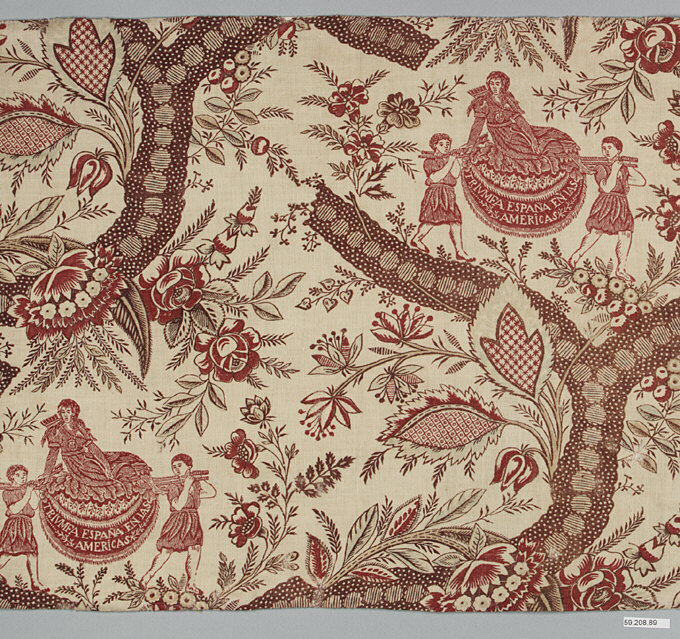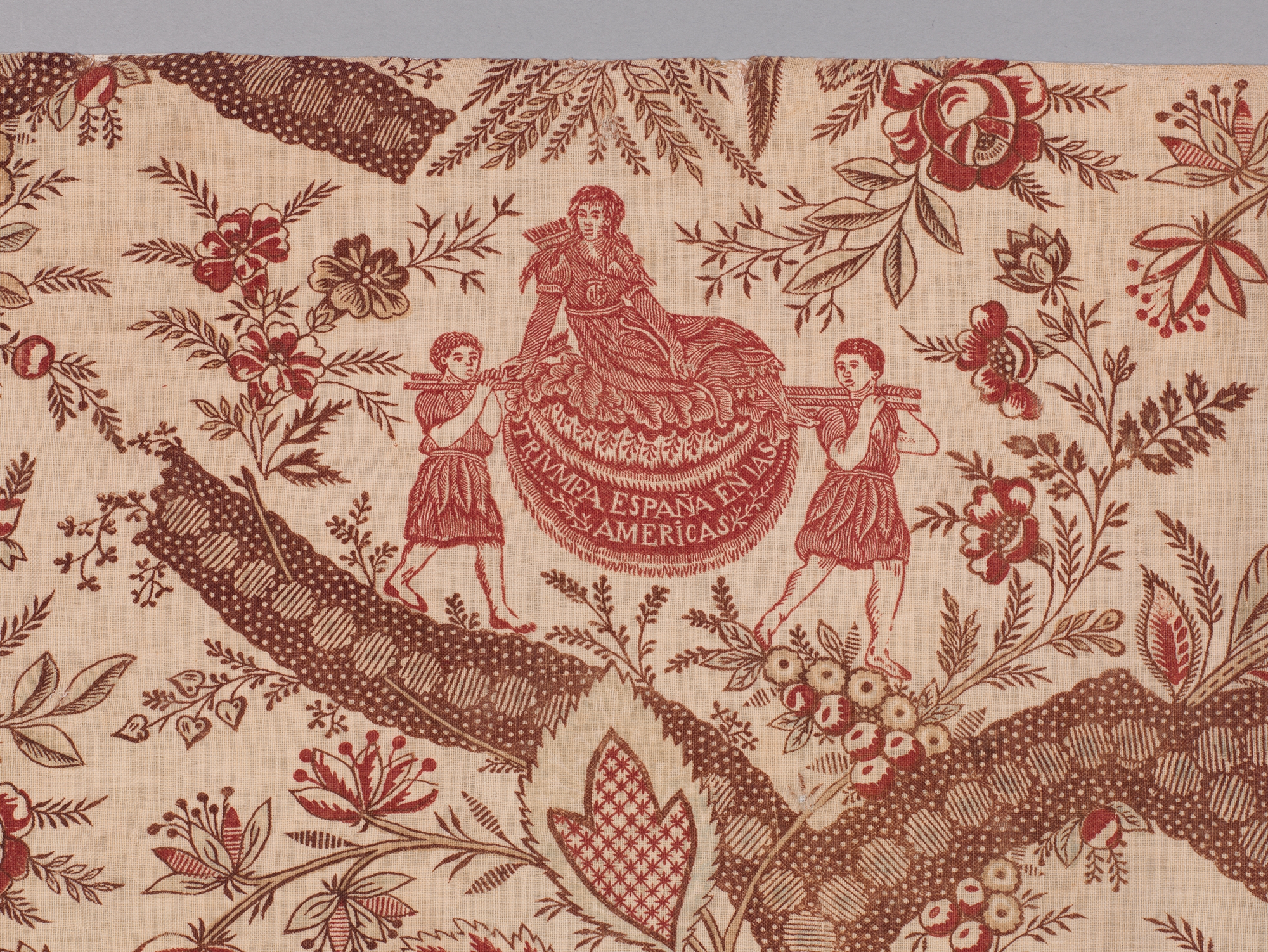Triumfa España en las Americas (The Triumph of Spain in the Americas)
Not on view
This printed fabric demonstrates the potential for textiles to serve as platforms for political and social declarations. See also MMA 26.189.2. Of probable Spanish origin, Triumfa España en las Americas depicts "America" as a Native American female upon a litter supported by two young men among stylized flora. Europeans began personifying the Americas as an exotic native woman in the sixteenth century, but the inclusion of the legend "Triumfa Espana en las Americas" suggests that the design’s authors were attempting to communicate something more explicit than the portrayal of the colonial Americas as a noble (but still inferior) savage. For most of the eighteenth century, Spanish rule in the Americas was marked by intense civil conflict across an exceptionally broad spectrum of colonial society, largely in response to the waves of colonial administrative reforms effected by the Bourbon rulers in Spain.¹ The Andean region alone witnessed more than one hundred insurrections between the 1730s and the Great Andean Rebellion of 1780 – 81 in Peru and Bolivia. Only months later, Spanish officials contended with another major uprising led by mestizos (persons of mixed descent) in the Revolt of the Comuneros (1781–82) in present-day Colombia and Venezuela. Given the violent resistance and general resentment festering in the Americas, it would not be surprising if the creator of this panel viewed it as an expression of affirmation for Spanish loyalists.
While Triumfa España artfully promotes European imperialism in the Americas as both universally accepted and enduring, Traite des Nègres (26.189.2) represents an attempt to undermine that authority. Frederic Feldtrappe designed Traite in France in the early nineteenth century. Of the four narrative scenes he included in the textile, two reference earlier paintings by English artist George Morland (1763– 1804), The Slave Trade (1788) and its companion, European Ship Wrecked on the Coast of Africa (1790), eventually dubbed African Hospitality. The works contrast the brutality of Europeans toward Africans (The Slave Trade) with the kindness of Africans who minister to a shipwrecked European family (African Hospitality). Among the earliest visual indictments of the slave trade, Morland’s paintings gained wide exposure after being published in 1791 as mezzotints by the well-known engraver John Raphael Smith, who took advantage of the rising antislavery fervor brewing in Britain in the 1780s and early 1790s. These scenes also appeared in France, printed by chez Depeuille of Paris in 1794. The other two scenes on this textile, Habitation des Nègres and Arrivée des Européens en Afrique, both from 1795, were based on engravings by Nicolas Colibert. Habitation shows a happy, intact African family enjoying the paradisiacal setting. In Arrivée the appearance of Europeans in Africa, laden with exchange goods, ominously foreshadows the horrors of the traffic in human beings.
That Feldtrappe tapped English visual precedents that predated his textile by several decades is not surprising, given the history and character of the French abolitionist movement and its relationship to its counterpart across the English Channel. The small, elite group that made up the Societe des Amis des Noirs, founded in 1788, was heavily influenced by the London Society for the Abolition of the Slave Trade, established the previous year.² In particular, the Amis adopted the English abolitionist tactic of condemning the trafficking of enslaved persons rather than the entire institution of slavery. Ostensibly this approach allowed antislavery supporters to condemn the trade without appearing to threaten the colonial economies, which could not be maintained without slavery. For many in the Amis, the end of the trade would (theoretically) mark the beginning of the end of slavery, which would gradually decline for the want of a supply of forced labor. Feldtrappe’s design reflects the perpetuation of this strategy that allowed observers of such images to curse the slave trader while taking their coffee with sugar, wearing indigo-dyed textiles, and decorating their homes with mahogany furniture—all products of the French-held islands in the colonial West Indies.
Images promoting the innate goodness or childlike nature of Africans had been a common trope in Western art during the early modern period, but news of the violence that occurred during the uprising of slaves, free blacks, and mulattoes in Saint- Domingue (present-day Haiti) would thereafter complicate this image. While the French state censored much of the news of the revolt, images circulated. Some abolitionists argued that reported violence against whites, which appeared in a few depictions of the Haitian Revolution (1791–1804), was the consequence of centuries of European cruelty.
Feldtrappe produced his textile during a moment of intense debate in France over the viability and morality of the slave trade, which was definitively abolished by the Second Republic in 1848. He drew from older antislavery images, illustrating the cultural currency they acquired over the long fight to end slavery and suggesting the challenges of representing slavery for abolitionists living in the aftermath of the French and Haitian revolutions.
[Melinda Watt, adapted from Interwoven Globe, The Worldwide Textile Trade, 1500-1800/ edited by Amelia Peck; New York: Metropolitan Museum of Art; New Haven: distributed by Yale University Press, 2013]
Footnotes
1. Intended to stimulate manufacturing and improve government efficiency, the Bourbon Reforms (Reformas Borbónicas) consisted of political and economic legislation introduced by the Spanish Crown during the eighteenth century. The reforms were also intended to limit the power of the Creoles living in the Americas and restore it to Spain. For more information on the reforms and their effects on the Americas, see Barbier, "The Culmination of the Bourbon Reforms," pp. 51–68.
2. The formal successor organizations of the Amis were the Amis des Noirs et des Colonies (1796–99) and the Societe de la Morale Chretienne (1821–60/1). For a detailed discussion of the French antislavery movement, see Jennings, French Anti-Slavery.
Due to rights restrictions, this image cannot be enlarged, viewed at full screen, or downloaded.
This artwork is meant to be viewed from right to left. Scroll left to view more.






